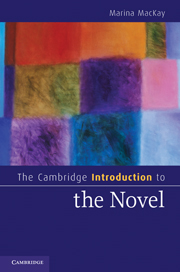Book contents
- Frontmatter
- Contents
- Acknowledgments
- About this book
- Chapter 1 Why the novel matters
- Miguel de Cervantes, Don Quixote (1605, 1615)
- Chapter 2 Origins of the novel
- Laurence Sterne, The Life and Opinions of Tristram Shandy, Gentleman (1759–67)
- Chapter 3 Narrating the novel
- James Hogg, The Private Memoirs and Confessions of a Justified Sinner (1824)
- Chapter 4 Character and the novel
- Nathaniel Hawthorne, The Scarlet Letter (1850)
- Chapter 5 Plotting the novel
- Gustave Flaubert, Madame Bovary (1857)
- Chapter 6 Setting the novel
- Charles Dickens, Bleak House (1853)
- Chapter 7 Time and history
- Virginia Woolf, To the Lighthouse (1927)
- Chapter 8 Genre and subgenre
- Graham Greene, The Ministry of Fear (1943)
- Chapter 9 Novel and anti-novel
- Thomas Pynchon, The Crying of Lot 49 (1966)
- Chapter 10 Novel, nation, community
- Salman Rushdie, Midnight's Children (1981)
- Chapter 11 Concluding
- Notes
- Glossary
- Further reading
- Index
- Cambridge Cultural Social Studies
Graham Greene, The Ministry of Fear (1943)
Published online by Cambridge University Press: 05 June 2012
- Frontmatter
- Contents
- Acknowledgments
- About this book
- Chapter 1 Why the novel matters
- Miguel de Cervantes, Don Quixote (1605, 1615)
- Chapter 2 Origins of the novel
- Laurence Sterne, The Life and Opinions of Tristram Shandy, Gentleman (1759–67)
- Chapter 3 Narrating the novel
- James Hogg, The Private Memoirs and Confessions of a Justified Sinner (1824)
- Chapter 4 Character and the novel
- Nathaniel Hawthorne, The Scarlet Letter (1850)
- Chapter 5 Plotting the novel
- Gustave Flaubert, Madame Bovary (1857)
- Chapter 6 Setting the novel
- Charles Dickens, Bleak House (1853)
- Chapter 7 Time and history
- Virginia Woolf, To the Lighthouse (1927)
- Chapter 8 Genre and subgenre
- Graham Greene, The Ministry of Fear (1943)
- Chapter 9 Novel and anti-novel
- Thomas Pynchon, The Crying of Lot 49 (1966)
- Chapter 10 Novel, nation, community
- Salman Rushdie, Midnight's Children (1981)
- Chapter 11 Concluding
- Notes
- Glossary
- Further reading
- Index
- Cambridge Cultural Social Studies
Summary
“Let me lend you the History of Contemporary Society. It's in hundreds of volumes, but most of them are sold in cheap editions: Death in Piccadilly, The Ambassador's Diamonds, The Theft of the Naval Papers, Diplomacy, Seven Days' Leave, The Four Just Men …”
Graham Greene, The Ministry of Fear (1943)When the twentieth-century British novelist Graham Greene divided his fictions into “novels” and “entertainments,” he implied a qualitative distinction familiar to all students of the novel. So, to give the examples of two books already mentioned, Greene's The End of the Affair, about an illicit wartime relationship ended by a religious conversion, was published as a “novel,” whereas, with its page-turning plot, its lowlife gangsters, and its seedy, sensational aura of degradation and crime, Brighton Rock was “only” an entertainment. But all readers of Greene know what's wrong with the distinction: that some of his “entertainments” are at least as complex and rewarding as his “novels,” rendering the terms useless for separating good fiction from bad. This interchapter makes a case study of one of Greene's best-known “entertainments,” The Ministry of Fear, a spy novel that reflects explicitly on the nature of genre fiction. While it's tempting to say that what differentiates literary fiction from the genre novel is that the former resembles life while the latter resembles only other novels, this is the very distinction that The Ministry of Fear overturns.
- Type
- Chapter
- Information
- The Cambridge Introduction to the Novel , pp. 144 - 147Publisher: Cambridge University PressPrint publication year: 2010

